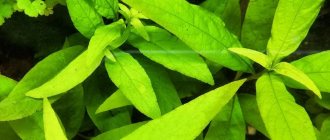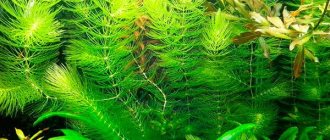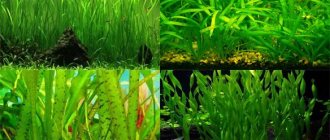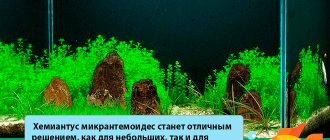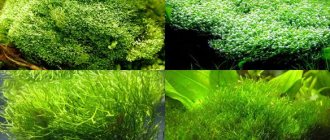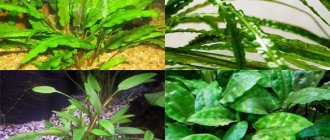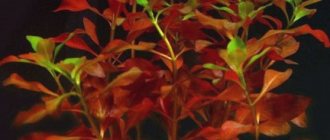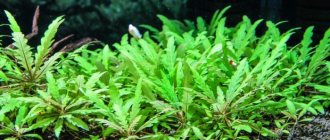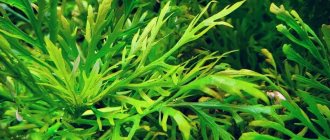Home › Aquarium plants › Catalog of aquarium plants ›
Your rating will be the first!
Belem (Syngonanthus sp. Belem) - one of the newest aquarium plants, recently introduced into the aquarium hobby and very quickly becoming popular, is known for being fastidious. It was first popularized in Japan, and only later gained recognition in North America and Europe. Unique in appearance due to its thin umbrella-shaped top, suitable for keeping only in soft water.
Growing and care
The plant was domesticated by Japanese collectors relatively recently, so it has not become widespread.
Tonina fluvatilis is not suitable for small aquariums (the height of the tank should be at least 40-60 cm), it places high demands on water parameters, and grows mainly in experienced aquarists.
Water parameters for ideal maintenance
Tonina fluviatilis prefers moderately soft, acidic water that does not stagnate. Accordingly, it is desirable to have a powerful filter, supply CO2 and change the water once a week by 1/5.
The recommended temperature is 20-27 degrees (the minimum acceptable value is 18 degrees, otherwise the plant will stop developing).
Lighting requirements
Tonina loves bright lighting (intensity of at least 1 W/l). The best option is a combination of fluorescent lamps and incandescent lamps. It is advisable that the leaves receive sunlight, but it is important to ensure that they do not become overgrown with algae.
In good light, the plant can reach 40 cm in height, but in this case it is recommended to shorten it. The top is pinched off after it reaches the surface of the water, and the resulting shoot can be planted separately.
Requirements for soil and nutrient substrate
Tonina is planted in sandy soil at least 5 cm thick.
The plant takes root well, but it needs time to acclimatize - immediately after planting it can stop growing for several weeks.
You can do without a nutrient substrate, but placing the plant in a new aquarium with unstable microflora is not recommended.
It is better to “start” it on simple plants, wait 4-5 months, and then plant Tonina fluviatilis.
Requirement for fertilizers
The plant can live without fertilizing, but responds well to microfertilizers and iron.
The recommended dosage of iron is 3 ml per day, but it is important to ensure that there is no “skew” of fertilizers.
It is believed that under natural conditions Tonina lives in symbiosis with mycorrhiza fungi, so material containing them should be added to the soil. This information has not received precise confirmation, so experienced aquarists rarely follow this rule.
TONIA BELEM (Tonina sp.Belem)
Ptichka
0
16 555
Share
Under natural conditions, tonina belem grows in the reservoirs of Central and South America adjacent to the mouth of the Amazon and is the closest relative of eriukalon. This plant first appeared in aquariums thanks to the Japanese one, which was able to adapt it for keeping in aquarium conditions. The plant owes its name “belem” to the name of the city near which it was first discovered. Due to the very high complexity of its maintenance, this plant can very rarely be found in the collections of aquarists.
By the way, if you are looking for a plot of land in Novosibirsk for low-rise construction, we advise you to contact, for which the sale of land plots in Novosibirsk has become one of the main areas of activity. By contacting us, our managers will be able to provide you with various options for land plots that meet all your requirements.
Thanks to its special decorative properties, the tonina belem will be a decoration in any aquarium. It is advisable to plant it in the middle or background, where it will create a contrast against the background of other neighboring plants. The combined composition of this plant and eriukalons and tonins looks very beautiful. In aquarium conditions, the size of the plant bush reaches up to 35 cm in height and 2-3 cm in width. It is necessary to plant in small groups.
I would like to immediately note that Tonina sp.Belem is a very beautiful and at the same time very difficult plant to maintain, which requires very bright lighting, intensity 1.0-1.5 W/l, and constant feeding with CO2. The duration of daylight should be no more than 10 hours per day. If a brown coating appears on the leaves of the plant, then it is necessary to increase the CO2 supply and reduce the light intensity.
Water parameters must satisfy the following conditions: temperature 20-30°C, hardness dH 1-4°, acidity pH 5.0-7.5. Feeding with iron-containing microfertilizers is required, which is necessary to maintain the rich green color of the plant.
According to some aquarists, tonina belem grows well with a water hardness dH of no more than 3°, when planted in an open place, with a light intensity of about 0.8 W/l. With these parameters, the plant grows, although slowly, but at the same time has an ideal appearance. As water hardness decreases, the growth rate increases, but at the same time the internodes increase, which generally affects the decrease in decorativeness.
Belem thinnina grows extremely slowly, and therefore is often shaded by plants growing nearby. This should under no circumstances be allowed, because... this will inevitably lead to her death.
To dilute the tonin with white, you need to break it off from an adult bush, the top of which has reached the surface of the water (5-7 cm long) and plant it in the ground, pressing it with a small stone.
Tags tonina belem, tonina sp Belem
Found an error or a dead link?
Select the problematic fragment with the mouse and press CTRL+ENTER. In the window that appears, describe the problem and send it to the resource Administration.
Reproduction
Tonina fluviatilis reproduces vegetatively. A small section of at least 5-6 cm long is plucked off from the top part, after which it is planted in the ground. While adult plants can live without CO2 supply, young plants require it around the clock, with microbubbles being preferred.
Continuation. Part 1.ERICAULONS (Syngonanthus). Genus Eriocaulon or woolstem (Eriocaulon) The genus was described by Lineus in 1753. One species, Eriocaulon septangulare, is common in Ireland and the Hebrides; E. ussuriense grows in the Far East. Annual species are all rosette plants; perennials form a rosette or a long stem. As a member of the Eriocaulon family, Syngonanthus is traditionally difficult to keep in an aquarium. The basic requirements for its maintenance are as follows: 1. Very soft water. 2. Carbonate hardness should not exceed 4 German degrees of hardness. With increased hardness, the plant turns brown starting from the tips of the leaves and disappears. So, a constant value of carbonate hardness is very important, which in extreme cases can have a value of 4 German degrees, although water with a hardness of less than 1 is much better suited. 3. Syngonanthus needs very strong light, more than a watt per liter, while it grows as if under MG, and under fluorescent lamps. 4. Very pure water is the main key when keeping this plant (osmotic water, remineralized with Calcium and Magnesium ions). 5. In this case, the pH is needed in the region of 5.0-6.5. 6. Requires a round-the-clock supply of Co2 to the aquarium and a meticulous supply of fertilizers according to the Macro, Micro and iron system. Syngonanthus likes it best when fertilizers are added to the aquarium in small doses evenly throughout the week. Acid soils such as Flora Base and Aqua soil are suitable for growing Syngonanthus; it also does well in Eco Complete if you add peat underneath the base soil. In this case, the soil depth is recommended to be at least 10 cm. Almost all available sources of information recommend strong biofiltration, and the filter must be powerful enough to create a strong flow and have adequate volume. Propagation is very simple; if maintained correctly, a healthy plant will form new tips at the top of the stem. These tops can be divided, leaving 3-6 cm of stem and planting them again in the aquarium. There is no need to leave a long stem, as it will sprout roots and look untidy at the bottom. Keeping the plant trimmed short will keep the plant looking cleaner, healthier, and more attractive. The lower part of the plant has no decorative or practical value and should be discarded. When properly maintained, this plant grows quickly and doubles its size in a week, forming a luxurious dome of rich green tops. Eriocaulon setaceum
General information: Height: 10…40 cm Width: 6…16 cm Lighting: Strong 0.80..1.00 W/l Temperature: 20…25 C Water hardness: Soft < 1 dgH Water acidity: Acidic Growth rate: Average Housing conditions: Very difficult Grows above water: No Eriocaulon setaceum is a purely underwater plant, only flowers come out of the water. In aquarium conditions it is a very difficult plant to maintain and breed. A very light-demanding plant (from 0.7-1W per liter). The water in the aquarium should be very clean and soft, slightly acidified, PH=(5-6.5), highly saturated with CO2. The plant requires a very nutritious substrate (with vermicompost or peat) with a large percentage of iron and regular feeding with liquid fertilizers. Under unfavorable conditions, the plant will die within a short time. Bristle-leaved woolly stem is a beautiful long-stemmed plant with moderate growth and a fan of green, needle-shaped, slightly downward-curved leaves, bristly or hair-like, collected in very dense rosettes and crowned with a luxurious top, up to 16 cm in diameter. Light trunk and whitish fibrous long roots. Its height (depending on the conditions of detention) is from 10 to 40 cm. Whorls with rosettes of leaves-needles are evenly distributed along the elongated and often branched white stem at the top. It looks like a small and very fluffy grass tree. As the stem grows upward, it constantly splits, so after some time a luxurious bush-sphere of tops is formed at the top. The plant is an excellent candidate for a decorative aquarium. In aquatic design, Eriocaulon setaceum can become a kind of “green” accent in the composition in the middle or background, and young plants resembling green hedgehogs can also be used in the foreground. Bristle-leaved Woolstem is propagated by simple transplantation of the tops (3-10 cm long along the stem), which are always more numerous than the roots. The plant does not like pruning; it produces shoots from the root, but very reluctantly. And the death of plants is very large. The main root quickly dies off during development, being replaced by adventitious roots that appear in large numbers, as if enveloping the thickened base of the stem. Eriocaulon sp. "Cinereum"/Ericaulon rosette.
General information: Height: 5…10 cm Width: 5…10 cm Lighting: Strong 0.80..1.00 W/l Temperature: 20…25 C Water hardness: Soft < 1 dgH Water acidity: Acidic Growth rate: Slow Housing conditions: Very difficult Grows above water: No Eriocaulon sp. from Japan middle/ Erikaulon “Japanese middle”.
General information: Height: 5…10 cm Width: 5…10 cm Lighting: Strong 0.80..1.00 W/l Temperature: 20…25 C Water hardness: Soft < 1 dgH Water acidity: Acidic Growth rate: Slow Conditions of detention: Very difficult Grows above water: No Source: https://aquariymist.4admins.ru/viewtopic.php?f=15&t=769
Plant varieties
There are several varieties of Tonina, which differ in the size of the leaf plate. The most common:
Tonina sp Belen
Tonina sp Manaus
Like Tonina River, they are quite whimsical and are not suitable for beginners.
Under natural conditions, Tonina reproduces not only by shoots, but also by seeds. Fruits, seeds and other plant germs are distributed by water currents.
Description, features of maintenance and reproduction
Leo Angel – February 2, 2020
The Eriocaulon family is divided into 2 subfamilies - the Eriocaulaceae subfamily and the Paepalanthoideae subfamily, to which several genera belong. The central genus of the pepalanthus subfamily, pepalanthus, includes more than 450 species, distributed exclusively in America. In addition, the subfamily includes the African-American genus Syngonanthus and the genus Tonina, common in tropical America.
River tonina (Tonina fluviatilis)
The only species in the monotypic genus Tonina. This species is distributed in southern Mexico, Central America, northern South America (Colombia, Venezuela, Ecuador, Peru, northern Brazil and Guiana), Cuba and Trinidad. In nature, Tonina fluviatilis is usually found in shallow waters, growing as floating mats in slow-moving streams. There are several variations of Tonina river, differing mainly in the size of the leaf blade. This species was first imported by Japanese hobbyists, who were the first to recognize its beauty and suitability as an aquarium plant.
Unlike the relatively xerophilic species of Brazilian campos, tonina is a true aquatic plant. The root system of tonina is not sufficiently developed, unlike other members of the family. Tonina fluviatilis has a long stem about 15-30 cm long. The lanceolate-shaped leaves on the stem are arranged alternately and collected in rosettes. The leaf blade measures up to 1.5 cm in length and 2.5 mm in width and is bright green or yellowish in color. Can grow in a semi-submerged state.
There are two types of propagation - by lateral shoots and by seed. While most Eriocaulonidae do not have special adaptations for dispersing seeds, which usually simply fall out of cracked capsules and can then be carried on the legs of animals with lumps of soil, hydrochory predominates in tonina.
River fineness places quite high demands on keeping it in an aquarium. Prefers sour and soft water. The light must be intense. CO2 is desirable.
Syngonanthus
Representatives of this genus in the family are not aquarium plants. You can verify this by looking at S.chrysanthus in natural conditions. This genus is widespread in tropical Africa and Latin America (from Mexico and Cuba south to Argentina). Several varieties have become widespread in the aquarium hobby: sp.Belem, sp.Madeira, sp.Manaus and sp.Rio-Negro, which were initially assigned to the genus Tonina, but later their affiliation was revised. At the moment they are classified as members of the genus Syngonanthus. It should be noted that the data belongs to sp. to the genus Syngonanthus has not yet been scientifically confirmed.
Syngonanthus were brought and cultivated by collectors from Japan, after which the plant slowly began to spread among professional aquarists. By their names these sp. owe to the names of the area near which they were first discovered. In the photo on the right you can see S.sp.Belem in its natural environment.
Due to the very high complexity of keeping, these varieties can very rarely be found in aquarist collections. Plants require very soft water with an acidic reaction and low mineralization. Without the supply of CO2, as a rule, they do not grow. The light must be intense. Perhaps the most demanding aquarium plants.
Aquarium varieties of syngonanthus are real aquatic plants. Their root system is not sufficiently developed - just like that of tonina fluviatilis. The plants have a long stem about 15-40 cm long. The leaf blades measure up to 5 cm in length and 1-2.5 mm in width and are colored bright green. Reproduction by lateral shoots.
It is believed that these plants live in symbiosis with mycorrhizal fungi, and therefore it is recommended to add material containing these fungi to the substrate around the plants to make them completely beautiful. However, there is no specific information about what types of fungi are required, and indeed whether mycorrhizal fungi were found in the root system of these syngonanthus.
Read more about the conditions of detention and the characteristics of reproduction in the Directory of Tonina and Syngonanthus.
Tonina fluvatilis in an aquascape
Tonina fluvatilis is an ideal plant for the foreground and background. It stands out effectively among other representatives of underwater flora and is suitable for any composition. True, it is not easy to choose one, since not everyone can live in strict but favorable conditions for Tonina fluviatilis.
It is best to plant the plant in aquariums with unpretentious plants or Eriocaulon (Eriocaulon sp. Ratonagiriuni, Eriocaulon sp. Goias, etc.), which require similar water parameters.
Another important point is to ensure that other plants do not shade Tonina. It grows slowly and may end up in the shadow of faster specimens, which is absolutely unacceptable.
Tonina fluviatilis is a fastidious plant that requires a lot of attention from the owner. There are cases when it stopped growing or died even if the growing conditions were met, but it’s worth trying to grow it - Tonina will become a wonderful decoration for the aquarium.
Aquarium and its inhabitants
An aquarium is not just a beautiful thing that satisfies a person’s aesthetic needs, and not only a means to fill one’s leisure time. This is a working model of a natural reservoir. An aquarium is intended for the maintenance and development of aquatic animals and plants, as well as for monitoring their life and development. The arrangement of an aquarium is an important factor for the life support of the fish and plants living in it. Lighting plays an important role. Light is necessary for both fish and plants. The latter, in the process of photosynthesis, consume carbon dioxide and form nutrients, while releasing oxygen, which fish breathe. In order for plants to grow and reproduce well, they must receive the required quantity (illumination), quality (spectral composition) and duration (hours) of light. Different species of fish react differently to light, so fish from turbid waters need shaded areas in the aquarium. Fish that prefer clearer water require good lighting. Properly chosen artificial lighting ensures the normal functioning of all organisms in the aquarium! An aquarium also needs a heater. The best temperature in the aquarium is 24-26 °C, the minimum is 22-23 °C. At lower temperatures, fish catch colds, get sick and die. Plants may also die. A filter is required in an aquarium . It is used to: — purify water from inorganic particles suspended in water; — removal of dissolved organic compounds and nitrogen-containing metabolic products from water; - removal of certain dissolved substances from water; - creating water circulation in the aquarium; — water aeration; — enrichment of water with certain substances dissolved in it. Fish, just like all other animals, breathe oxygen, but only oxygen dissolved in water. For this you need a compressor, which saturates the water with oxygen . The main types of ornamental aquarium fish. The bream barb is native to northeast India and Bangladesh. Prefers standing and slowly flowing water. Length up to 15 centimeters, in an aquarium up to 8 centimeters. The body is an elongated oval, thickened on the sides, the lateral line is incomplete. The mouth is terminal, there are no antennae. The male has a shiny green to olive green back, the side and belly are silvery with a yellowish to reddish tint. At the beginning of the caudal peduncle there is a black spot with a golden edge. The fins are reddish, the dorsal fin has a black tip. The male is smaller than the female, slimmer, and turns red during the spawning period. The female is gray-green to dull bronze in color, with almost colorless fins. Before spawning it becomes very fat. The fish are peaceful, schooling, mobile, occupying all layers of water. Sensitive to insufficient oxygen content in water. When there is a shortage of plant food, it bites off the soft leaves of plants. Water: 18-22 °C. Speckled catfish or common catfish. Lives in the southeastern part of Brazil. Length up to 7 centimeters. The body is olive-brown to olive-green, with blackish spots and small specks of varying sizes on the back and sides. The fins are gray with black spots and streaks. The male is smaller and slimmer than the female. There is a red-eyed albino form with pink body coloring. Water: 18-24 °C. Swordtail (family Poeciliaceae). The length of the male (without sword) is up to 8 centimeters, the female is up to 12 centimeters. The body is elongated, thickened laterally. The male has a slimmer body. The lower rays of the caudal fin are greatly elongated and resemble a sword in shape. The female's body is fuller and taller. The main color is yellowish-green, in reflected light it casts green or blue. From the end of the snout through the eye to the caudal fin there is a zigzag dark violet or purplish-red stripe, bordered on both sides by narrow stripes, first green, then carmine red. The brown edging of the scales forms a mesh pattern on the body. The fins are greenish-yellow; the dorsal fin has small red to brown streaks and spots. The most common are red swordtails of varying color intensities - from brick to ruby. The most valued is intense red, without light spots on the belly, with pigment extending into the eyes. Beautiful red swordtails with black fins. Calico swordtails have black spots scattered across the red background, merging towards the tail. The male's sword is orange-yellow, but can be green or red, with a black edge. The female is paler in color. A separate transformation of females into males is observed, especially when they are kept separate from males. Guppy. They live in the northern part of America and on the islands of Barbados and Trinidad. As a result of artificial acclimatization, they spread across all continents. The length of the male of the natural form is up to 3 centimeters, the female is up to 6 centimeters. In selection forms, the male is up to 4.5 centimeters, the female is up to 8 centimeters. The male's body is elongated, slender, somewhat flattened laterally. The female's body is also elongated, with the posterior part more flattened laterally. The male's natural form is olive-gray with multi-colored dots and spots, the female is gray with a greenish, olive or bluish tint. Peaceful fish stay in the upper layer of water and can jump out of it. Water: 20-28 °C. Flag platylia. They live in fresh and brackish water bodies along the Gulf of Mexico. The length of the male is up to 10 centimeters, the female is up to 12 centimeters. The body is elongated and quite high. The dorsal fin is wide and high; in the male it can exceed the height of the body. The color varies greatly. Often there is a dark back, the side is brownish on top, pink or blue below, scales with a pearlescent sheen with red, blue, dark green or black dots. There are 6-7 dark stripes on the belly. The throat and belly are silvery-white. The dorsal fin is light blue with rows of black dots and a yellow to orange border. The caudal fin is blue below, bluish-gray in the middle, with orange dots on top or with a pearlescent sheen, it can be green on top with black dots, orange-yellow in the middle and green streaks below. The female is paler in color than the male. There are piebald and completely black forms, as well as albinos. By crossing with the sailfin molly, a breed with a large sail-shaped dorsal fin with an orange border was developed. Peaceful fish, but fish with large fins are kept separately, because fish with regular fins can tear them. It is better to maintain a group with a predominance of females. Water: 24-28 °C. Black molly or short-finned platy. They live in bodies of fresh and brackish water. The length of the male is up to 8 centimeters, the female is up to 12 centimeters. The body is elongated, with a high caudal peduncle, slightly flattened laterally. Breeders have developed many colored forms, including a black one called black molly. Peaceful fish, stay in the middle and upper layers of water, love the sun or light from lamps with a high proportion of red rays. Water: 24-28 °C. Cardinal (carp family). They live in fast-flowing streams near the city of Guangzhou (PRC). Length up to 4 centimeters. The body is elongated, slender, in the front part it is slightly flattened laterally. Upper mouth. The back is dark brown with a greenish tint, the side is brown, the belly is silvery-white. In the middle of the body from the snout to the caudal fin there are two adjacent stripes. The upper one is narrow, golden, and the lower one is wide, dark brown, which end at the caudal fin with a black spot. The caudal fin is red in the middle with light yellow, sometimes colorless, blades. The remaining fins are yellowish with a red border, with the exception of the pectoral fin, which has a narrow, black border. The male is slimmer than the female. Peaceful, mobile, schooling fish, stay in all layers of water. Water: 18-25 °C. Common angelfish (family Cichlidae) . Inhabitant of the region from the Amazon River delta to the Marañon River and from the Amazon River to the Orinoco River. Length up to 15 centimeters. The profile of the forehead may have a break at the level of the upper edge of the eye. The anal and dorsal fins are bluish-gray. The spiny part is almost black-brown, the soft-ray part has a number of yellowish-brown stripes, the same stripes on the caudal fin. Peaceful, sedentary fish that do not tolerate pollution well. They are frightened by sudden, rapid movements around the aquarium and especially inside it, as well as strong instantaneous changes in illumination. Water: 25-27 °C. Aquarium plants: Lesser duckweed (plant of the duckweed family). Found almost everywhere. Grows in stagnant and slowly flowing waters. The plant floating on the surface of the water consists of a round plate with a diameter of up to 0.5 centimeters, light green in color, with a thread-like root 6-8 centimeters long extending from it. Propagated by daughter plants formed at the edges of the leaf blade . Serves as food for some herbivorous fish. Clears the water of suspended matter, intensive growth indicates the normal biological state of the aquarium. Water: 15-30 ° C. Hornwort is light green (family Hornwort). Found in bodies of water with standing and slow-flowing water. A rootless aquatic plant with an elongated stem and whorled leaves. The leaf is palmately dissected. The whorl contains 6-12 repeatedly dissected leaves of light green to red color, with 5-8 apices, the segments are very thin, long, slightly toothed. The plant is planted in a group in the ground in the middle or background of the aquarium or allowed to float in the water column. Propagated by cuttings. Water: 16-28 °C. | |||
